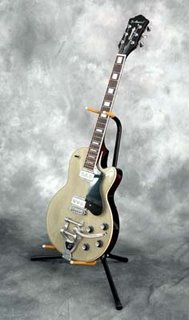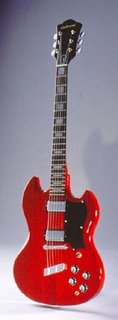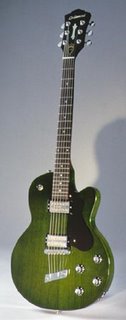Irony is that most of their product is made in Asia. They've absorbed the product lines of Gretsch and Guild guitars and now manufacture the actual guitars in Indeonesia, Korea, Japan, or increasingly, China. Thanks to CNC technology, the build quality of these instruments is off the scale. An entry level instrument today is 1000 times the value of the overpriced vintage instruments hoarded by aging boomers who just want to play Freebird after a few rounds at the Country Club. And that's just based on sheer playability.
Here in New York, the outsourcing of labor is especially tragic considering the history behind the instruments and their production in the area. Both Guild and Gretsch Guitars were headquartered in the NY/NJ region for many, many years. Friedrich Gretsch, a German immigrant, built the company up from scratch, and eventually would up creating a magnificent Deco building in Brooklyn just to house the company. It's still standing, but nowadays it's been retrofitted into million-dollar plus lofts for actresses and rock stars.
The Guild company was started by striking Epiphone workers and ex-Guild staffers . They literally walked off the job, established their own union (or Luthier's Guild, hence the name) and started cranking out axes. No idea what became of their factory in Jersey , but the guitars were out of production for many , many years, which is a shame. The Guild electrics were some of the most unusual American guitars ever produced, combining an aggressive design philosophy with solid construction. They were the underdog alternative to the ubiquitous Strats, Teles, SG's and Les Pauls that dominate the market today. And they disappeared without a trace when the company went under in the late 1980's.
Enter Keith Brawley. The former Fender product manager recreated the classic Guild instruments, and rebranded them as DeArmonds, which was the name of the famous aftermarket pickup produced by The DeArmond/Rowe company beginning in the 1940's. The instruments were, of course, made in Asia.
Strangely enough, that was exactly when Korean manufacturing and quality control reached a new plateau. The quality of the guitars and basses was incredibly high, and the prices were very low. DeArmond's didn't last long at all, were eventually folded into the Squier line, and then deleted.A major guitar chain sold all of them off for firesale prices a few years ago. Once people grabbed them up, they were amazed at how good they were, and the legend grew.The sole reason for their popularity now is their affordability, high production quality, and physical/tonal resemblance to Gretsch /Guild instruments.
Nowadays, they're always up on ebay, with the ceiling for the rarest models topping out around $500 dollars, which is a little rich for my blood.
I've owned (and sold) a few of these guitars over the past few years, so here's a brief overview.

The M-75T were dual single coil 24.75 scale instruments. They were mostly produced for FMIC by Cort of Korea, who also manufacture guitars for a lot of other major names.
The M-series DeArmonds all featured the same single cutaway tilt headstock design and were of varying quality. The low end ones are still a lot of fun to play, particularly if you swap out the stock pickups and are handy with a can of Krylon. Unlike many of the other guitars in the DeArmond line, this one wasn't built as an homage to Guild: it's more of a DuoJet derivative, down to the sparkly finishes. Let's see....what else. Chambered body, supposedly. Bigsby clone vibrato. The metal parts have a tendency to oxidize very easily.
I bought one in 2005 that had small pockets of rust on every metal surface except for the tuners.It sounded phenomenal,albeit a bit thin, and was one of the smoothest playing instruments I've ever had. I have no idea why I sold it, and am still looking for a replacement. This silver sparkle model is more commonly seen. It sounds very, very rockabilly.Commonly available for $200-$400 online.
 The S-65 pictured here was the low end of the S-series. These were direct copies of the Guild S-100's and Polaras that were produced throughout the '70s and '80s . Bolt-on neck, 24.75 scale. Made in either Korea or Indeonesia. Some people insist that the Korean models are better, but I don't know about that. They all pretty much feature the same stuff. Inlays are huge, and feel like plastic or some type of PVC. The pickups are sort of uninspiring, as is the somewhat sterile tone. They are very good looking guitars, however, and feel very solid overall. I owned and sold one after it just sort of languished in its case. These were later reissued as Squier models, and then deleted again.
The S-65 pictured here was the low end of the S-series. These were direct copies of the Guild S-100's and Polaras that were produced throughout the '70s and '80s . Bolt-on neck, 24.75 scale. Made in either Korea or Indeonesia. Some people insist that the Korean models are better, but I don't know about that. They all pretty much feature the same stuff. Inlays are huge, and feel like plastic or some type of PVC. The pickups are sort of uninspiring, as is the somewhat sterile tone. They are very good looking guitars, however, and feel very solid overall. I owned and sold one after it just sort of languished in its case. These were later reissued as Squier models, and then deleted again.The next model up is the S73, which is a set-neck beast that definitely captures the growling tone of its Guild forebears. There's also a 12 string model that is pretty well coveted. $100-$450 online.
 The M70 is the sleeper secret of the whole DeArmond line. Set neck, equipped with Goldtone pickups, and generally available in finishes that range from a strange, depressive green to a ridiculously tiger-striped photo finish yellow.
The M70 is the sleeper secret of the whole DeArmond line. Set neck, equipped with Goldtone pickups, and generally available in finishes that range from a strange, depressive green to a ridiculously tiger-striped photo finish yellow.These guitars feature a strange combination of pimped-out gaudiness and stripped-down functionality and sound really good. They got it right with this model.
Ditching the PVC inlays in favor of a trad dot-neck design helps the feel of the neck, and the heel-body transition is remarkably smooth. This is a Bluesbird copy, and it's easy to understand why these guitars were semi-popular with bluesmen, country pickers and wannabes in their heyday. It feels like you could hammer 2x4's into place with this thing, but the metal is also prone to the same rust issues as the gear on the M-75T. $200-300 online.
There are other models out there that look interesting, but I've never played them. As always, look around. Prices vary wildly on these guitars, and only a small amount of brand-name inflation has crept in. They're worth it at the current rate.
Rock on.
J. A.